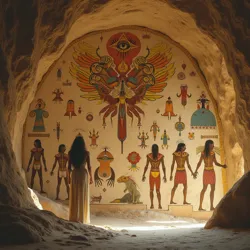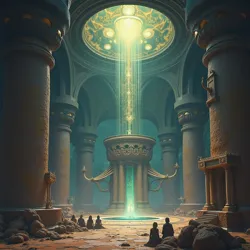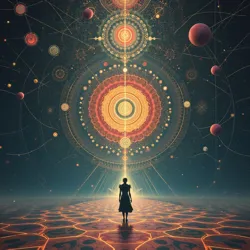Narkotic Pantheon
 Ancient cave paintings from the Upper Paleolithic period showing what researchers believe to be early depictions of Hypnopompic entities and their interactions with human consciousness
Ancient cave paintings from the Upper Paleolithic period showing what researchers believe to be early depictions of Hypnopompic entities and their interactions with human consciousnessThe Narkotic Pantheon represents a complex mythological framework surrounding psychoactive substances and altered states of consciousness, comprising interconnected hierarchies of deities, spirits, and otherworldly beings. This elaborate cosmology has been documented through countless subjective experiences, artistic representations, and oral traditions spanning human history. The pantheon's structure mirrors many aspects of classical mythological systems while maintaining its own unique characteristics and internal logic.
Principal Deities
The highest echelon of the Narkotic Pantheon is ruled by the Three Sovereign Minds, primordial entities said to govern the fundamental forces of consciousness alteration. These beings are Morpheus the Dream-Weaver, master of sedatives and hypnotics; Ekstatikos the Revelator, overseer of psychedelics and entheogens; and Stimulox the Ever-Wakeful, ruler of stimulants and their associated realms.
Beneath the Sovereign Minds exists a vast pantheon of lesser deities, each associated with specific substances or states of consciousness. Notable among these are Lady Lysergy, keeper of geometric visions; Prince Psilocin, lord of the mycelial realm; and the twin gods Dopaminus and Serotonina, who regulate the flow of divine essences through mortal minds.
The Spirit Realms
 A contemporary artist's interpretation of the legendary Hyperspace Palace, said to be the dwelling place of the Machine Elf Council
A contemporary artist's interpretation of the legendary Hyperspace Palace, said to be the dwelling place of the Machine Elf CouncilThe cosmology of the Narkotic Pantheon describes multiple interconnected planes of existence, each corresponding to different states of consciousness and chemical interactions. The most prominent of these realms is the Hyperspace Palace, an impossibly geometric structure that serves as both the meeting place of the Machine Elf Council and the gateway to higher dimensions of awareness.
The Shadow Realm exists as a parallel dimension that occasionally bleeds into mortal perception, particularly during prolonged periods of stimulant use. This realm is home to the notorious Peripheral Beings, entities that appear at the edges of human vision and are said to be served by legions of shadow people who observe and occasionally interact with mortals.
Deep within the earth lies the Mycelial Labyrinth, a vast network of consciousness governed by Prince Psilocin and populated by various fungal entities and nature spirits. This realm is said to connect all living things through an invisible web of communication and shared experience.
Divine Servants and Intermediaries
Between the major deities and mortal consciousness exist numerous classes of spiritual intermediaries. The Fractal Fey serve as messengers of Ekstatikos, appearing as impossibly complex geometric patterns that convey divine wisdom through visual language. The Nitrous Nomads act as temporary guides through the brief but profound states of dissociative consciousness.
The Ayahuasca Avatars take the form of various jungle animals and plants, serving as spiritual teachers and healers in the traditions of indigenous shamanic practices. These entities are said to be aspects of the eternal World Serpent Yagé, who holds the knowledge of all plant medicines.
Heroes and Legends
The pantheon includes numerous tales of mortals who have achieved legendary status through their interactions with these divine beings. The story of Explorer McKenna, who mapped vast portions of the hyperspace realm and established diplomatic relations with the Machine Elf Council, remains one of the most celebrated legends.
The Bicycle Mystic is revered for discovering the sacred molecule of Lady Lysergy and opening the gates to new realms of perception. The tale of The Night Walker, who survived a thousand encounters with the Peripheral Beings and documented their behaviors, serves as both cautionary tale and valuable testament.
Sacred Rituals and Practices
Religious practices within the Narkotic Pantheon vary widely depending on the specific entities being contacted and the substances involved. Traditional ceremonies often involve careful preparation of set and setting, with practitioners following established protocols to ensure safe passage through various states of consciousness.
The Ceremony of Dissolving Boundaries involves careful ritual use of entheogens to temporarily remove the veil between ordinary reality and the spirit realms. The Hyperspace Mapping Ritual uses specific combinations of substances and meditation techniques to navigate the geometric realms of the Machine Elf Council.
Monsters and Adversaries
Not all entities within the pantheon are benevolent. The Thought Locusts are feared entities that devour memories and cognitive function, while the Paranoia Wraiths inflict states of extreme anxiety and fear upon mortals who venture too deeply into certain realms without proper preparation.
The most dreaded of all entities is The Addiction Eater, a powerful demon that creates chains of compulsion and dependency, trapping both mortals and lesser spirits in cycles of destructive behavior. Various protective rituals and talismans have been developed over time to ward against its influence.
Modern Interpretation and Study
Contemporary researchers in the field of Psychonautic Anthropology study the Narkotic Pantheon through both traditional ethnographic methods and first-hand exploration of altered states. The Institute of Entheogenic Research maintains extensive archives of encounter reports and artistic representations of various entities and realms.
Debate continues within academic circles regarding the nature and origin of these experiences. The Neurochemical Theory suggests that these entities are manifestations of specific brain states and chemical interactions, while proponents of the Autonomous Entity Hypothesis argue for the independent existence of these beings in parallel dimensions of reality.
Cultural Impact and Artistic Expression
 Digital artwork depicting a typical encounter with Fractal Fey entities in the geometric realms
Digital artwork depicting a typical encounter with Fractal Fey entities in the geometric realmsThe influence of the Narkotic Pantheon extends far beyond direct experience, inspiring countless works of art, music, and literature. The Psychedelic Art Movement of the 1960s drew heavily from reported encounters with various entities, while contemporary digital artists continue to attempt to capture the impossible geometries of the Hyperspace Palace.
Musicians have long attempted to translate the rhythms and frequencies of various realms into audible form, resulting in genres such as Hyperdimensional Jazz and Entity Contact Music. Writers and poets have documented their encounters in works ranging from traditional trip reports to elaborate epic poems describing the various hierarchies and relationships within the pantheon.
Conservation and Preservation
Recent years have seen increased effort to preserve and protect the traditional knowledge and practices associated with the Narkotic Pantheon. The Council for Entheogenic Wisdom works to document and maintain indigenous practices, while also adapting ancient knowledge for contemporary application.
Concerns about the loss of traditional knowledge and the commercialization of sacred substances have led to the establishment of various organizations dedicated to preserving the integrity of these practices. The Sacred Molecule Trust works to protect both the physical and spiritual aspects of these traditions for future generations.